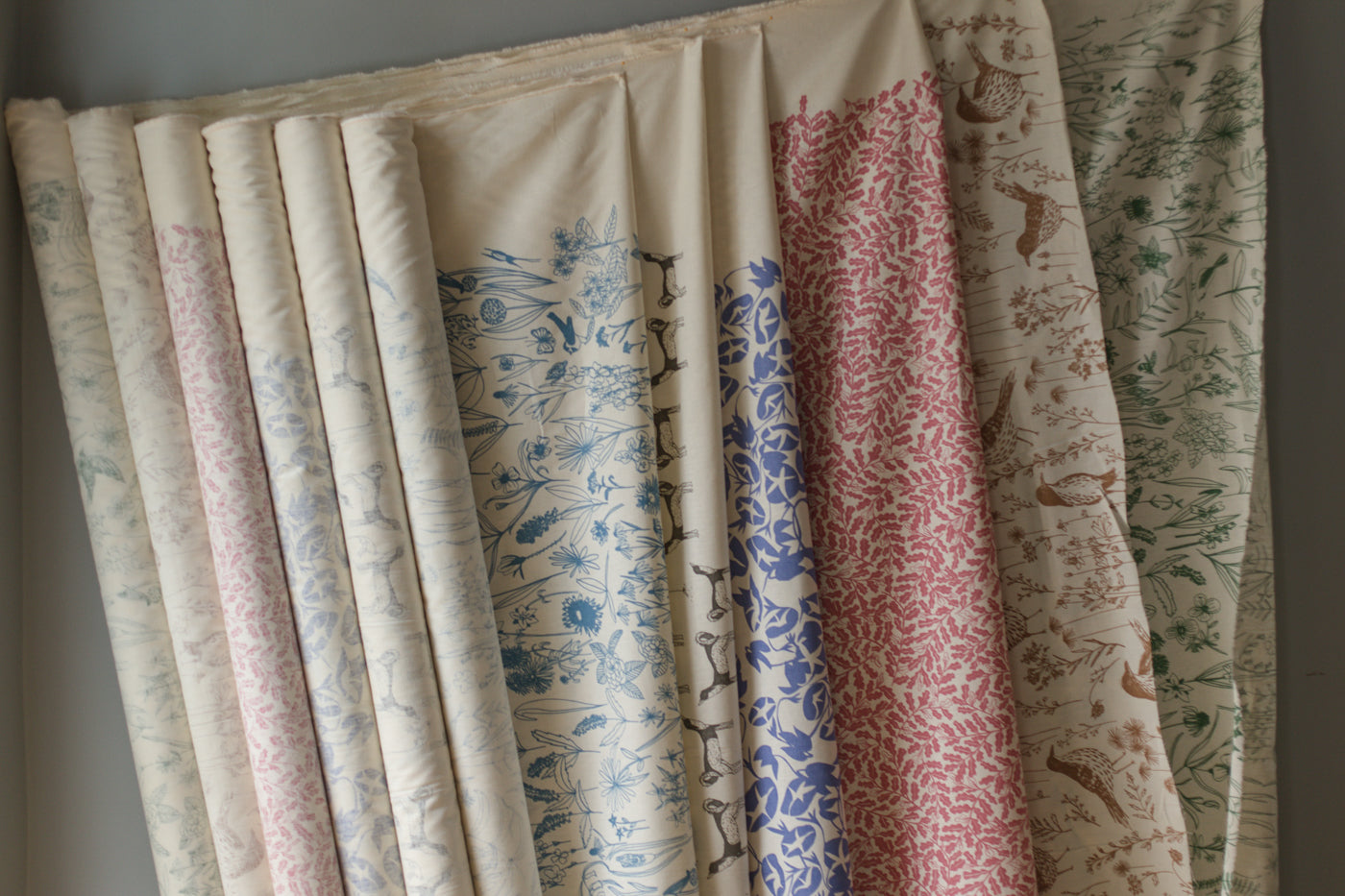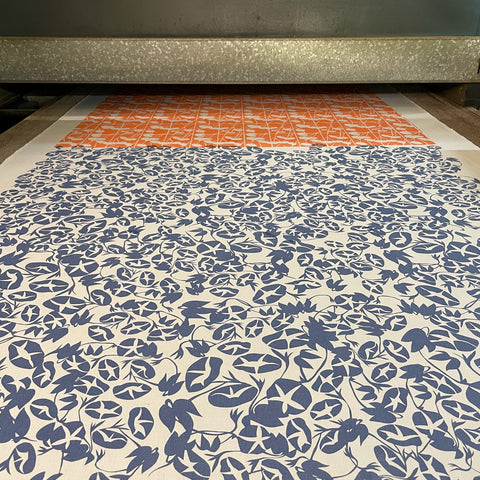
Back in June, I got some bad news: the local print shop where I heat-set my fabric had sold their conveyor dryer.
Heat-setting is a critical step in textile printing; it ensures that the ink is fixed to the fiber. Without it, the printed colors would fade almost completely after a wash or two. I was lucky to have access to that giant, gas-powered beast, as most places with dryers don't offer them as a service. For a while I was shipping my fabric to and from a place in Rhode Island that agreed to help me out, but that wasn't practical.
(here's fabric coming off the conveyor dryer)
[On a side note - It’s easy to heat-set smaller pieces of printed fabric using a heat gun, iron, or even throwing it in the dryer. But as a yardage printer, that just doesn’t make sense.]
(Painstakingly using a heat-gun to set yardage, circa 2011)
Losing access to the dryer forced me to evaluate how the business has developed over the years and make a firm decision about how to move forward. Do I buy a dryer? Scale up? Change shape?
Back in 2010, I convinced Simon to move with me to Georgia from Chicago to start a textile printing business. Space up there wasn't cheap, but down here I could set up a print table, dark room and washout booth in my parents' empty basement. It was tight, but it worked.
With the skills we picked up in art school and my experience in a screenprinting shop, we set about building what we needed while working in my folks' pest control business. We spent weeks padding a table and getting the right equipment, testing exposure times and ink consistency.
(The studio in my folk's basement was tight, but we made it work)


A year later, Simon got a library job in Athens (I worked in the family business for a while longer and then got a job up here, too), driving 80 minutes back to my folks' house every weekend to print. Over the next few years, the business grew one tiny step at a time. After we bought our house in Athens we once again built out a basement studio. This time we had the luxury of a larger space. The house is on a steep hill, giving us 12' ceilings in the studio. The previous owners were thoughtful enough to leave it unfinished except for stud walls and some plumbing options. We were able to design our own space, framing walls and building a washout booth ourselves before calling in the professionals for plumbing, electricity and drywall.
(Print tables going in at the home studio)
Over the years, I've tried out many different design and product ideas, moved from Etsy to my own website, sold at craft shows, artist markets, farmers markets, fancy retail stores, quilt conventions, and my open studio sales. Some ideas have stuck around since the beginning (like the favorite Dogs design), while many other ideas fizzled out (trying to wholesale while keeping my prices reasonable).
(Booth setups over the years)



But when I heard that the conveyor dryer had sold, it was time to figure out what was and wasn't working. I needed to re-evaluate the plan.
Over the course of a couple of weeks, Simon suggested I sit down and work through an iterative writing exercise to identify my options. Starting with a giant list of random thoughts related to my business, it progressed through several stages until I arrived at four distinct paths. Those four paths were then developed with as many details as I could think up, along with pros and cons.
#1. Stay the course. Buy my own (smaller, electric) dryer and turn the garage into a heat-setting space.
-- While this would solve the immediate problem, the reality was that the dryer was just the latest trouble with the process. Over the years, we constantly struggled with issues related to our tiny business size. Our base cloth supply would randomly change in color and quality, and they'd run out of stock at the worst times. When I quit my office job to do this full time, I needed a printing assistant, but could never find someone who could produce an even print reliably. So we'd produce loads of not-quite-good-enough yardage that would be cut down into smaller pieces and sold as bundles. Our makeshift print tables were never quite level, our ink supplier would randomly change formulas, etc, etc. In the end, it didn't make sense to buy an expensive dryer, tuck it in the garage and continue with all the other difficulties.
(Printing large scale yardage in our tiny set-up had it's own difficulties)
#2. Scale up. Take out a business loan, rent a building, and buy better equipment.
-- If printing and selling yardage were the main dream, this would have to be the next step. Along with improving the equipment, though, I'd have to hire more staff and increase production and sales to meet the next expenses. My prices would have to double to cover the new overhead costs, meaning my wonderful repeat customers whom I've come to know would end up priced out. I'd have to spend most of my time as a business manager instead of a creative artist. Definitely not the dream.
(Pinning fabric before printing)
#3. Textile/surface designer. Outsource printing, hire a marketing assistant, and schmooze.
– Hand-printed fabric is a beautiful and skilled craft. I could hire a company to print my designs. There are a few US-based factories that do this work, but it comes at a cost, as it should. And I wouldn’t have the luxury of choosing my base cloths, or mixing my ink colors. Plus I’m back to being a manager, taking out a loan to meet minimums, quadrupling price points, and having to schmooze with folks wealthy enough to afford my fabrics. The other option would be to have my designs digitally printed, independently or through a fabric company. But I’m not interested in making more and more fabric in the world. I’m interested in the skill and craft of hand-printed fabric.
(what can I say, I wanna do the work myself!)
#4. Change shape
I had achieved my original dream from Chicago - to have my own textile screenprinting business. I also learned just how much bunk was in that fantasy: the glossy Facebook and Instagram pictures of the artisan masking the ugliness of modern commerce. The eco-friendly, sustainability image that amounts to marketing buzzwords for the vast majority of companies, and the near-impossibility of carrying out a truly ethical practice (especially as a microbusiness). I love making things, but the core of it all isn't selling tea towels made from hemp/organic cotton. Business-as-success fantasies aside, it has always been about designing, drawing, and making.
I’ve come to the realization that I’m not interested in managing a bigger company, or a production factory. I love to print on fabric and make things, but that’s linked to the tiny size of my business, and I’m fine with that. Going into debt to heat-set fabric, manage employees, and meet sales goals is just not important to me. Making art is.
(the not so shiny picture of me drawing at the kitchen table)
At the same time, I’m not going away! I love having a tiny business, selling the things I make to folks who appreciate them. My online shop will stay open, but it will reflect what I’m working on, which for now won’t be hand-printed fabric yardage.
When hit with a potentially major setback, I was very privileged to be able to entertain all of my options, and for that, I’m very grateful. I’m incredibly lucky to have Simon’s support, my family, and you. So thank you for supporting my work all these years, and I hope you’ll continue to follow along with me!
Xo,
Sara
Sue on Oct 15, 2022
You are so very wise! Kudos on your process and staying true to your art.
Carly on Oct 15, 2022
I wish you the best, Sara! It’s really interesting to hear your thoughts on this topic. It seems like it’s hard to have control over your work in an environment where you’re at the whims of suppliers. I look forward to seeing your business evolve!
Linda on Oct 14, 2022
Sara,
Thank you so much for sharing your journey & process in figuring out your way forward with creating art & your business! I am rooting for you whatever you choose to do moving forward.
Ellen Phelps on Oct 14, 2022
Sara…I wish you the best. I have supported your business because you make exceptional designs on fabric and I will always try to support a small business maker rather than a huge impersonal company. It will be interesting to follow your journey as an artist, so I look forward to seeing what you do next. Please keep me on your email list!
Ellen.